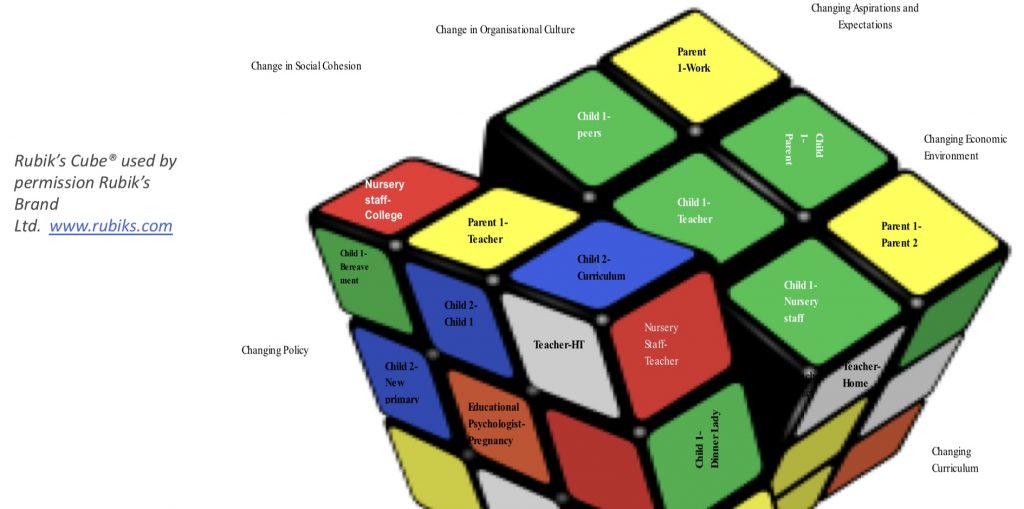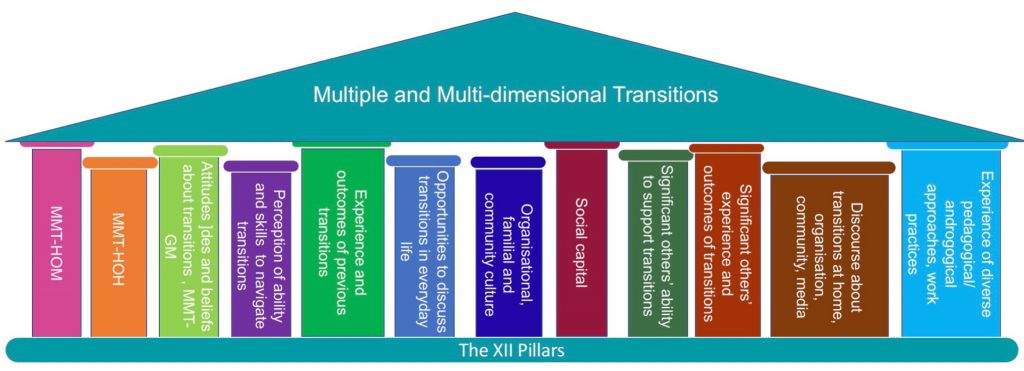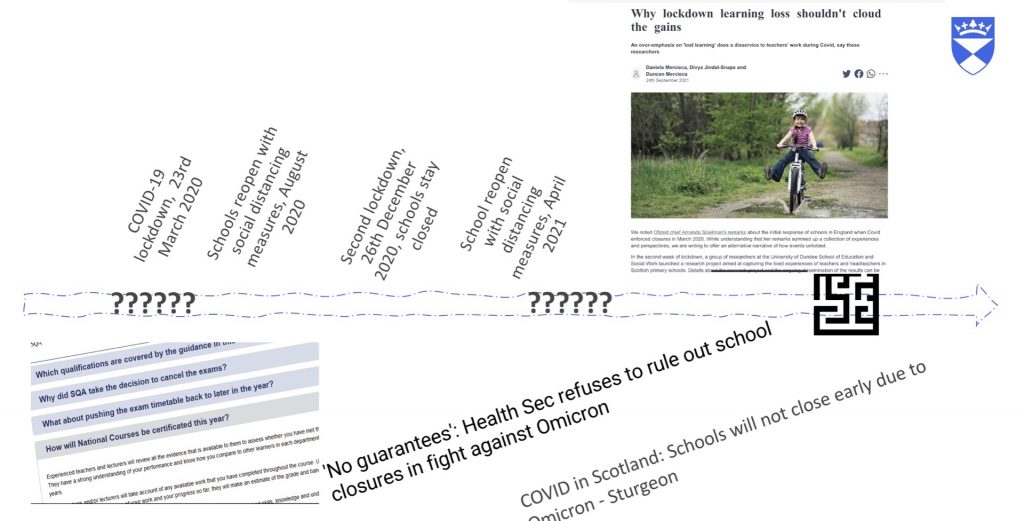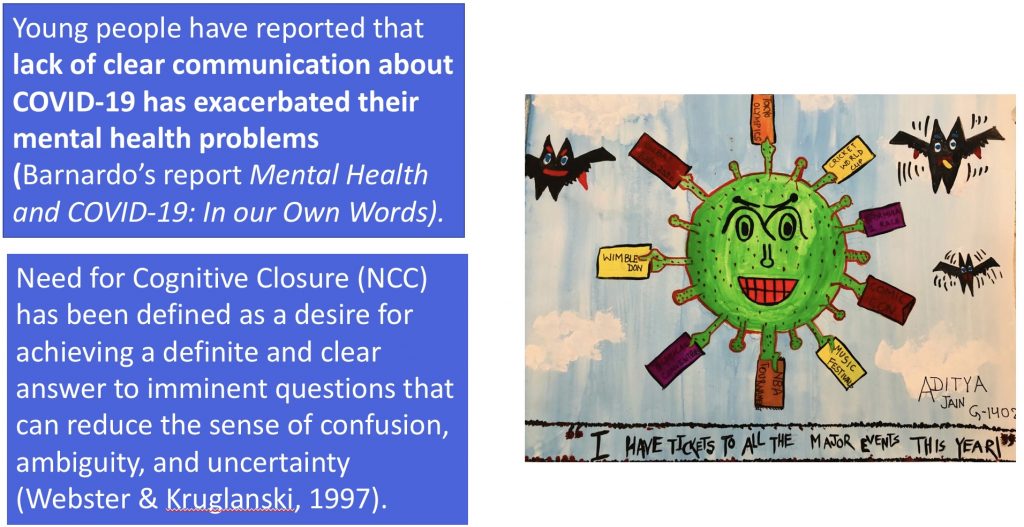By Divya Jindal-Snape
Our research suggests that certain dispositions and environmental dimensions can lead to successful educational and life transitions (Glazzard et al., 2020; Gordon et al., 2019; Jindal-Snape et al. 2020, 2021; Jindal-Snape & Cantali, 2019; Jindal-Snape & Foggie, 2008; Jindal-Snape et al., 2019; Jindal-Snape & Miller, 2008). These include certain beliefs and experiences about transitions, relationships, discourses and support systems available in that individual’s environment. They lead to the development of dynamic social-psychological-educational-cultural resources that the person has at their disposal when navigating transitions. I have synthesised them as XII pillars of successful Multiple and Multi-dimensional Transitions (MMT). Let’s remind ourselves first of what my MMT theory is.
Multiple and Multi-dimensional Transitions (MMT) Theory
The Multiple and Multi-dimensional Transitions (MMT) theory proposes that each individual experiences multiple transitions and that their transitions can trigger transitions for significant others. Conversely, significant others will be experiencing their own transitions and these transitions will trigger and/or have an impact on that individual’s transitions. These mutual interactions of transitions between individual and significant others lead to an almost ongoing ripple effect across the ecosystem, highlighting the multi-dimensional nature of the theory (Jindal-Snape, 2016, 2018). To understand it better, I have used Rubik’s cube as an analogy. Let us imagine that each individual and their interactions with others are represented by one colour. If we twist the Rubik’s cube slightly, the changes don’t happen just for one colour, it leads to changes for the other colours too.

Similarly, if one set of interaction or aspect of life changes, it can lead to changes across the spectrum. The changes might be similar to a small ripple effect or much more significant like a domino effect. Therefore, it is important to understand the multiple layers and complexities of these multiple transitions across multiple dimensions. Further, these transitions for individuals are happening within the context of wider changes in the policy, legislation, socio-economic environment, and cultural context over time, e.g., COVID-19 related changes.
The XII Pillars of Multiple and Multi-dimensional Transitions (MMT)
Before discussing these twelve pillars, it is important to highlight that for successful transitions, not all pillars have to be present or have to be equal at the same time. Further, different pillars might need to be prioritised at different times and for different types of transitions. These pillars are useful for an individual across the life course and when navigating different types of transitions. It is also important to note that these are not within-person or fixed, rather they can be, and are, created and maintained over time. These pillars are complex, dynamic and impact on each other in multiple ways. They are inseparable but have been separated here for ease of understanding.
The XII pillars of successful MMT are:
- Multiple and Multi-dimensional Transitions Habits of Mind (MMT-HOM)
- Multiple and Multi-dimensional Transitions Habits of Heart (MMT-HOH)
- Attitudes and beliefs about transitions (e.g., MMT Growth Mindset)
- Perception of ability and skills to navigate transitions
- Experience and outcomes of other multiple and concurrent transitions
- Discourse about transitions at home, school, workplace, in the wider community, media
- Social Capital (social connections/networks/relationships)
- Significant others’ ability to support transitions (e.g., family, professionals, peers)
- Significant others’ experiences and outcomes of their own transitions
- Opportunities to discuss transitions in everyday life
- Experience of diverse pedagogical/andragogical approaches/work practices
- Organisational, familial and community culture

These pillars can be generated consciously and purposefully but require multiple approaches and effective partnerships between the key stakeholders. Conceptualisation of pillars in this way can highlight what resources the child has to navigate their transitions successfully and where a teacher and/or family member can support the child access the resources available to them.
Habits of Mind are ‘thinking’ dispositions that help an individual in acting intelligently when they experience a new situation or problem.Teachers and families can support the development of children’s Habits of Mind related to transitions (Multiple and Multi-dimensional Transitions Habits of Mind, MMT-HOM) by providing children with opportunities to learn, for instance, how to solve problems, adaptability, open mindedness, collaboration, resourcefulness, agency, and comfort with uncertainty. The latter is particularly pertinent in the context of COVID-19 with so many uncertainties as can be seen below.

The uncertainty can be detrimental to some individuals’ wellbeing due to their functional need for cognitive closure.

You can check your own NCC here. An understanding of your own NCC is helpful in understanding what your transitions support needs might be.
Similarly, Multiple and Multi-dimensional Transitions Habits of Heart (MMT-HOH) can be developed by learning how to adapt to changing relationships (and social capital), understanding and managing feelings about transition experiences, and most importantly self-compassion. MMT-HOM and MMT-HOH are habits that interact with each other and can be developed throughout one’s life, but require, for instance, teachers to use diverse pedagogical approaches to support different children with different preferred learning styles.
MMT-HOM and MMT-HOH are likely to support the child in understanding and accessing their social capital to navigate their transitions in new classes/schools and with new teachers and peers. Similarly, a child’s social capital is likely to influence their MMT-HOM and MMT-HOH, and attitudes and beliefs about transitions (e.g., understanding of the dynamic nature of transitions and that transitions outcomes are also not static and they have the agency to change negative outcomes to positive over time, i.e., Multiple and Multi-dimensionalTransitions Growth Mindset; MMT-GM).
This can then influence the child’s perception of their own ability and skills to successfully navigate transitions. For instance, a child when confronted by a new and unexpected situation, is more likely to have a positive attitude about transitions and would believe that they can manage it, if they know how to solve a problem creatively and/or know how to adapt to change, and are self-compassionate when finding it difficult to solve the problem.
Further, the interactions between the child and his/her environment will also have an impact on their attitudes towards transitions and perception of their own ability to navigate them successfully. These include discourse about transitions in their environment, and their experiences and outcomes of other multiple and concurrent transitions and significant others’ (e.g., family, professionals) ability to support the child’s transitions. The latter is likely to be influenced by the significant others’ own transitions experiences. Other pillars will interact with these, for instance, opportunities to discuss about transitions in everyday life (e.g., excitement and concerns, finding out strategies used by significant others), and the culture of the old and new nursery/schools, families and their community.
The XII pillars of MMT provides a conceptual framework that can be used by teachers, families and other professionals from early years onwards but can be used along the life course. For instance, teachers can use pedagogical approaches that can develop children’s MMT-HOM and MMT-HOH. Teachers and families can also provide children with opportunities to discuss their own, and also explore children’s, beliefs about transitions, excitement/concerns, and strategies used by them when they had experienced similar transitions. Further, teachers, families, the wider community and media can ensure the discourse about transitions is positive. However, undoubtedly this discourse in the child’s environment will be a reflection of other’s own transitions experiences, beliefs, attitudes and dispositions. Further, it is important to note that it would be easier to influence some pillars more than others.
My plan is to create educational resources to support the development of all of these XII pillars which I will share in due course.
Here is a video, if you would like to hear me talk about the XII Pillars (starts from 46.1 to 1.01.38).
Acknowledgements: I would like to thank Dr Neha Agrawal, Professor Jonathan Glazzard, Dr Anna Robb, Dr Charlotte Bagnall and Dr Kazuhiro Kudo for feedback on the first iteration of this conceptualisation. Thanks also to Nik Snape for discussions regarding the conceptualisation of this framework as pillars.
Divya Jindal-Snape is Professor of Education, Inclusion and Life Transitions at the University of Dundee.
Images and figures copyright: Divya Jindal-Snape
